India 500 BC to AD 300
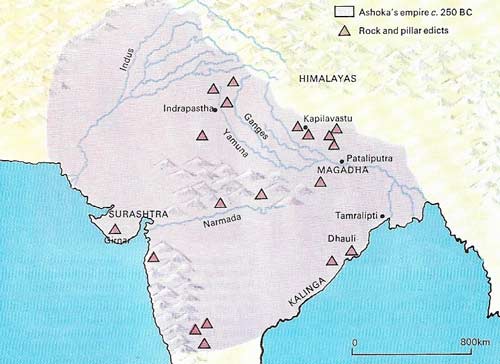
Figure 1. The Mauryan Empire was the greatest of the states of ancient India. It comprised most of the subcontinent, except its southern most portion, and most of Bengal and Sind. It also included significant parts of present Afghanistan, thus controlling the all-important overland communications with the Middle East. The size can be accurately established on the basis of the sites of the Shokan rock and pillar edicts. Centralized administration of this vast empire was simplified by a network of highways connecting Pataliputra with the provincial centers.
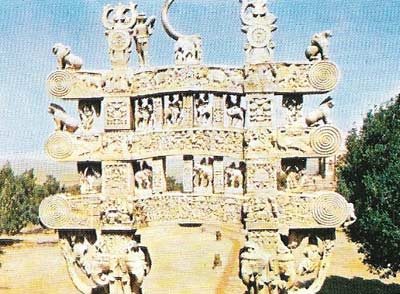
Figure 2. The rich sculpture of the eastern gateway of the great stupa at Sanchi shows both pious Buddhist stories and local deities belonging to folk religion but tolerated by Buddhism. The Buddhist stories concern either the important events in the life of Lord Buddha or stories relating to his earlier existences as a man or an animal. Popular religion is represented by various deities such as yakshas (tree spirits).
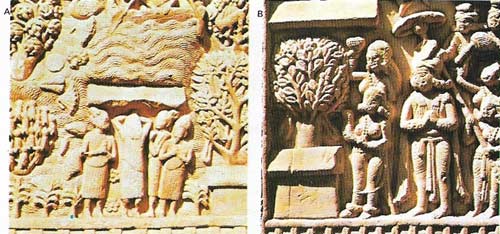
Figure 3. The Buddha is said to have converted people by performing miracles such as walking on water, depicted here (A) in the carvings on the gateway at the Sanchi stupa. The presence of Lord Buddha, who is not represented in this early period, must be inferred. Another scene (B) shows Buddha's father paying homage to the tree under which Lord Buddha attained enlightenment. This time the presence of the Buddha has to be inferred from the tree.
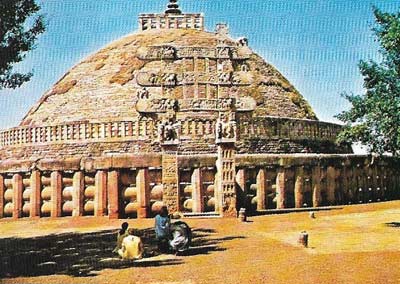
Figure 4. The great stupa (dome-shaped shrine) at Sanchi was built in Ashoka's time, but the railings and the richly sculptured gateways were added during the following two centuries. Sanchi, situated at the center of India where the main highways from east to west and from north to south crossed, was one of the principal Buddhist centers from at least the time of Ashoka to the 10th century AD; it also gave its name to a school of sculpture.
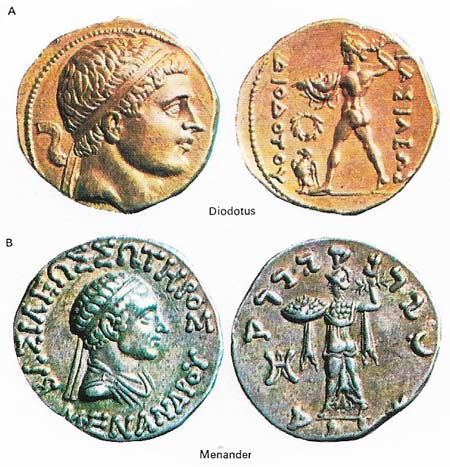
Figure 5. After Alexander had left India in 325 BC, several of his governors founded small independent principalities in Bactria and northwestern India. Some of these Greeks were strongly influenced by the Indians. For example, the coin (A) of Diodotus (fl. 3rd century BC) compared with the coin of Menander (B) (c. 150 BC) shows Indian influence, particularly in the use of an Indian script.
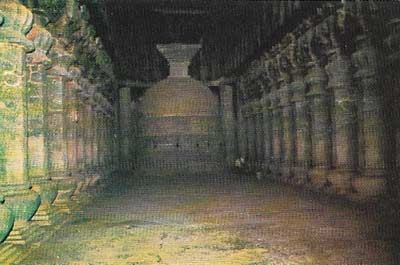
Figure 6. According to Buddhist tradition, caves have been used by the community of Buddhist monks since early times, especially as shelters during the rainy season. Although they were gradually replaced by structural monasteries, the tradition was continued in parts of India where numerous caves were excavated between 100 BC and AD 900.The chaitya cave at Karli, Maharashtra (c. 50 BC) was not used as a dwelling but as a place of worship, as well as for monastic ceremonies. It consists of a long pillared hall with a small stupa, enshrining relics of Lord Buddha, at the end. The rich sculpture of the capitals of the pillars presents a striking contrast to the sober lines of the rest of the cave.
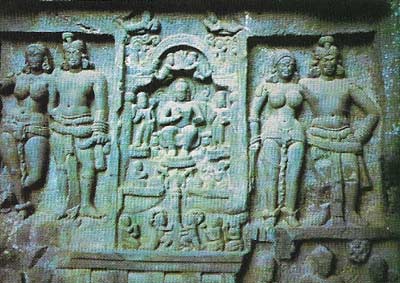
Figure 7. Another richly decorated part of the caves at Karli, Maharashtra, is the facade, which includes the space between the three entrances. In addition to traditional Buddhist scenes, there are usually representations of the pious donors of the caves and especially of the land which was donated for the requisites of the monks. The donors are usually couples, thus illustrating the high status of women in this period in western India.
The age of Buddha (c. 563–c. 483 BC) (Figures 3 and 4) marked the beginning of a world religion and of important developments in the political and socioeconomic fields. It was an age in which different religions (such as Jainism) emerged and a period of change in which established values were questioned.
Trade and political change
In the political field large and expansionist states developed, four of which dominated the scene by 500 BC. The most powerful of these was Magadha in southern Bihar with its capital originally at Rajgir, later at Pataliputra (Patna). The main economic asset was iron but power was also due to energetic rulers who gradually eliminated their rivals by force and diplomacy.
Cottage industries, such as textiles, pottery and metalcraft, flourished and were organized in guilds. Their produce, as well as agricultural surplus, was traded between various north Indian centers and with the Achaemenid (Persian) Empire in the west. Most trade was financed by bankers who supplied the means of transportation and took the risks. Such activities favored the rise of a prosperous class that included many who felt dissatisfied with the then rigid divisions of Hindu society. Such people often became enthusiastic patrons of Buddhism and other non-Hindu religions.
These developments were temporarily disturbed by the invasion in 327 BC of Alexander the Great (356–323 BC) who, after conquering the Persian Empire, set out to occupy its Indian provinces. But attracted by the legendary wealth of India, he advanced farther and managed to penetrate the Punjab. Alexander was, however, forced to retreat, soon to be followed by the governors whom he had appointed to rule the territories after his departure (Figure 5).
The glorious Mauryan age
The retreat of Alexander left behind a strong sense of Indian unity which found a leader in the young warrior Chandragupta (c. 321–c. 297 BC). First he liberated the western provinces and then he marched against Pataliputra, where he defeated the Nanda king of Magadha and so founded the Mauryan Dynasty in 320 BC. In his bid for the throne, Chandragupta was assisted by his able and cunning minister Kautilya, who is regarded as the author of the most important Indian work on statecraft, the Arthashastra.
The Mauryan age (320–185 BC) was one of the most glorious periods of Indian history. Chandragupta controlled northern India from the Hindu Kush to Bengal and probably parts of southern India as well. The kingdom was largely centralized, partly because of a network of highways. In 305 BC Chandragupta concluded a treaty with the Greek Seleucus (c. 355–281 BC) who sent Megasthenes (c. 350–c. 290 BC) to the Indian court as an envoy to grant Chandragupta formal rights over Alexander's conquests in India.
The Mauryan Empire (Figure 1) reached its zenith under Chandragupta's grandson Ashoka (c. 274–c. 236 BC), the mightiest king of ancient India. At first Ashoka continued to follow traditional expansionist policies but, after a cruel campaign against Kalinga (the present state of Orissa), he renounced further conquests by force. Instead he substituted conquest by righteousness. At about that time Ashoka was converted to Buddhism and became one of its most fervent supporters.
To propagate his ideas Ashoka had edicts engraved on rocks and pillars. These edicts enjoined upon the population a common ideology based on the concept of loyalty towards one's elders and those in authority and also on justice and mercy for one's neighbors.
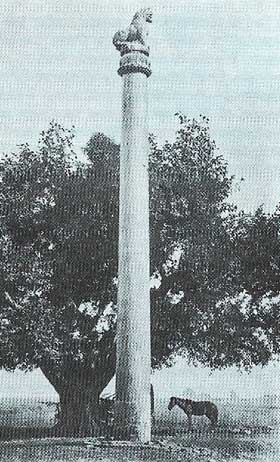 |
| The pillars of Ashoka are a series of monolithic columns dispersed throughout the Indian subcontinent, erected or at least inscribed with edicts by the Mauryan Emperor Ashoka during his reign from c. 268 to 232 BC. |
The Indo-Greeks and the Kushan Dynasty
The Mauryan Dynasty continued to rule over vast areas of India until 50 years after Ashoka's death but its authority soon declined. By about 185 BC the army commander Pushyamitra, in one of the earliest recorded military coups, overthrew the last Mauryan king and founded the Sunga Dynasty. The center of the state was soon moved from Bihar to central India. Pushyamitra was a powerful ruler but his successors could not prevent incursions by the Bactrian Greeks, descendants of some of Alexander's generals. Some were repulsed by the Indians, while others founded short-lived kingdoms in the Punjab and elsewhere. Many of these were influenced by Indian culture and because of this they are usually called Indo-Greeks.
The Indo-Greeks were soon followed by invaders from central Asia and in AD 78 most of northern India was under the control of Kanishka (died c. AD 100) of the Kushan Dynasty of Scythian origin (from central Asia). Like other Scythians, Kanishka was a pious Buddhist.
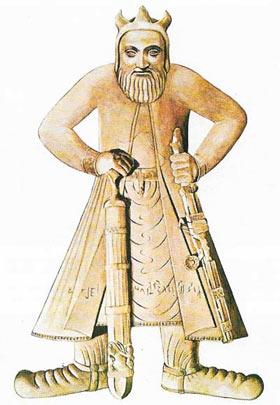 |
| Kanishka I, the greatest of the Kush-an kings, ruled over vast areas of central Asia and also controlled most of northern India eastwards as far as Bihar. This modern illustration is based on a torso of Kanishka (as indicated by the inscription), to which the head has been added from one of Kanishka's coins. The Scythian mantle and boots convey a strong impression of power and authority. |
A century later, however, the Kushans had been expelled from India and a Hindu reaction followed. Sanskrit, the language of the sacred texts, developed into a medium of communication among the upper class, in administration and, above all, in literature. The great Sanskrit epics, the Mahabharata and the Ramayana, although incorporating much older tradition, were probably written down during this period, as were the Laws of Manu, the basic code of Hinduism. These three texts together incorporate the basic values of Hinduism and so laid the foundations of the classical age of India in the Gupta period (AD 320–550).
